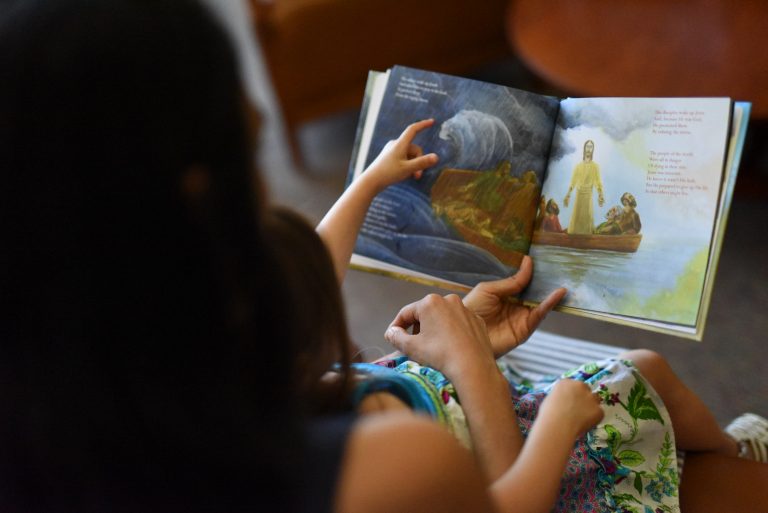By Maura Roan McKeegan
Maura Roan McKeegan is the author of the Old and New Series of children’s picture books introducing children to biblical typology. She is a homeschooling mother and a former classroom teacher who studied graduate theology and reading education. Her articles have appeared in publications such as Catholic Digest, Catholic Exchange, The Civilized Reader, Franciscan Magazine, Guideposts, and Lay Witness.

In 1945, my mother received a picture book called Jesus and I in honor of her First Communion. She kept the book among her beloved treasures for over 60 years, until the day she gave it to her granddaughter—my daughter, Grace.
“I loved that book,” my mom said, and the faraway look in her eyes spoke silently and powerfully to me of her memories. I envisioned my mom as a child, sitting on her living-room sofa, leaning on her father’s arm, leafing through the pages of this book and learning about the love of Jesus through the words and pictures in a way that would last a lifetime. Would she ever have guessed, back then, that one day her granddaughter would turn the same pages and discover the same love?
I never cease to marvel at the power of stories and books to create memories and build bonds. A book can reach across generations, drawing hearts together in the joy of a shared experience. In His infinite wisdom, God designed His messages of love to reach us through the pages of a book, and countless families throughout history have gathered around the stories of the Bible. When we share books and stories with children to help them understand God’s love, we wrap them in the spiritual blanket that God knitted from the beginning of time—the blanket that we can pull around ourselves and our children as we cuddle up together and delight in the gift of the Living Word.
Reading stories from the Bible, picture books about the Faith, biographies of saints, and other books aloud with children will also impart another gift: These books help our hearts become more childlike.
“Unless you turn and become like children, you will never enter the Kingdom of Heaven,” Jesus says in Matthew 18:3. I believe one way we can become like children is by reading aloud stories in our homes and families.
For some people, the idea of reading aloud is daunting. They might wonder: How do we do it? How do we get children to sit and listen? If you would like to read aloud with a child but find the idea intimidating, here are a few tips to help you begin:
1. Look for a time when the child isn’t distracted by other things and warmly invite him to read with you. It’s important to make reading a joy and not a chore, because a child might resent reading if he’s forced to do it when he wants to be somewhere else. If reading is a treat—if he gets to stay up 10 minutes past bedtime in order to read a book with you, or if he gets special time with you after lunch to snuggle up in a comfortable spot and read together—then the child will forever connect reading books with feelings of safety, comfort, and love.
2. When you’re reading, don’t worry about asking comprehension questions, checking to see how much the child understands and quizzing him to see if he’s listening well. Such questions steal the joy from reading together and turn it into a homework assignment. If you don’t pressure children, and you just read for the sake of enjoying the book together, they will learn to love books, and they will pick up and remember the parts that are meaningful to them. If they read with you because they love it, they will ask questions if there is something they need to know, because they will want to understand. So, set the comprehension questions aside, relax, and just read for the pleasure of it.
3. Try setting out a variety of books that you’ve selected, and then letting the child choose which one she’d like to read. She will appreciate the gift of choice, and by choosing the stack to begin with, you will still get to ensure that any selection she makes is a worthy one.
4. Draw children with love, not coercion. Forcing a book runs the risk of breaking the child’s desire to read. If there’s a particular book you want to read, though, by all means share your enthusiasm for it! As my college elementary-education professor used to say, “Enthusiasm for reading is caught, not taught.” Also, don’t make the child to read the book aloud to you (unless she wants to); just let her rest and enjoy hearing you read without pressure.
5. Remember that not every book will resonate with every child in the way we hope it will. If the child doesn’t like the book, don’t push it, or it could backfire. You won’t like every book you pick up, and neither will your child. If neither of you likes a book, don’t feel like you need to keep going with it. Just because a book is about the faith doesn’t mean it will automatically be a great book. Feel free to find another one you like more! Respecting the child’s choices and interests will go a long way in raising a reader who will one day want to read these same books with his own children.
6. Don’t worry if a little one is holding books upside-down or just carrying them around instead of reading them “the right way.” It’s all part of the road to reading, and it fosters a love of books. Also, don’t be alarmed if a child is not sitting for books yet, or sits only for a page or two. Just keep offering. Children will sit when they’re ready, for longer intervals as they grow older and the stories awaken their interest.
7. If you’re reading the Bible together, remember that the passage doesn’t have to be long. Even a few verses can be enough to give the child something to ponder for the whole day. Each word in Scripture contains the inexhaustible depth of God’s voice. Children might glean more from savoring small bites at a time than from trying to swallow an oversized portion.
8. If you’re reading picture books with paraphrased Bible stories and no imprimatur, and some of the paraphrasing leaves you scratching your head, children might enjoy looking up the actual stories in the Bible with you and comparing the words. For example, one popular children’s Bible storybook begins by saying that when God created the world, he said, “Hello light!,” and then, to the light, God said, “You’re good.” Genesis, however, tells us that God actually said, “Let there be light,” and that “God saw that the light was good.” In trying to bring Scripture down to a child’s level, the storybook alters theological concepts, in this case making it sound as if God greeted a creation that was already there and then spoke directly to it as if it were a living being, rather than creating it and acknowledging its goodness as His inanimate creation. If you decide to read aloud a book like this, it can be helpful to let children hear and see the actual Scripture verses alongside it so that they can “play detective” with the differences.
9. If you’re reading saint stories, remember that it is not the quantity of information about saints but the relationship of the child to the saint that matters most. It’s wonderful to read about a new saint every day, but you don’t need to feel catechetically responsible for covering a hundred saints in a hundred days. You could spend months reading a little bit every day (or every few days) of a chapter book about one saint, giving your child the chance to get to know that saint in great depth. If you’ve covered one saint in a hundred days and the child knows and loves that saint, your time has been well spent.
10. Let your own laughter or tears flow freely if you read something together that moves you. The joy, gratitude, and awe for the gift of faith that children hear in your voice and see on your face can remain in their hearts long past childhood.
As you escape the chaos of the world and curl up to read books in peace with the children in your lives, may you find light and life with every turn of the page in the story of God’s merciful love.
You Might Also Like

The Old and New Series by Maura Roan McKeegan brings biblical typology to life for children. Full-color illustrations tell the stories of the Old and New Testaments side by side. The series includes the award-winning The End of the Fiery Sword: Adam & Eve and Jesus & Mary; Into the Sea, Out of the Tomb: Jonah & Jesus; and Building the Way to Heaven: The Tower of Babel and Pentecost.